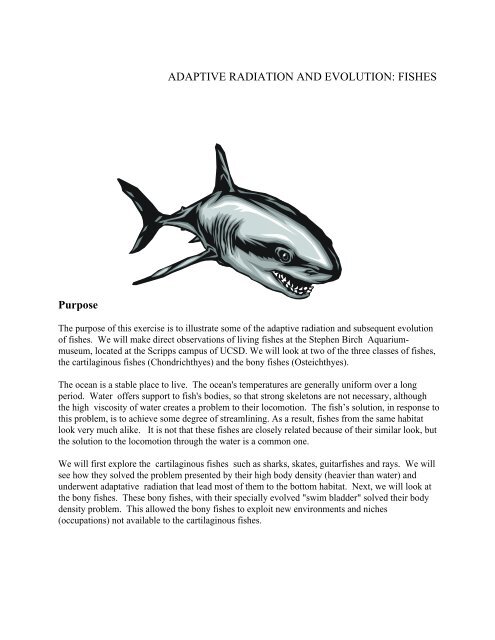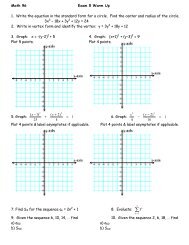ADAPTIVE RADIATION AND EVOLUTION: FISHES
ADAPTIVE RADIATION AND EVOLUTION: FISHES
ADAPTIVE RADIATION AND EVOLUTION: FISHES
Create successful ePaper yourself
Turn your PDF publications into a flip-book with our unique Google optimized e-Paper software.
<strong>ADAPTIVE</strong> <strong>RADIATION</strong> <strong>AND</strong> <strong>EVOLUTION</strong>: <strong>FISHES</strong>PurposeThe purpose of this exercise is to illustrate some of the adaptive radiation and subsequent evolutionof fishes. We will make direct observations of living fishes at the Stephen Birch Aquariummuseum,located at the Scripps campus of UCSD. We will look at two of the three classes of fishes,the cartilaginous fishes (Chondrichthyes) and the bony fishes (Osteichthyes).The ocean is a stable place to live. The ocean's temperatures are generally uniform over a longperiod. Water offers support to fish's bodies, so that strong skeletons are not necessary, althoughthe high viscosity of water creates a problem to their locomotion. The fish’s solution, in response tothis problem, is to achieve some degree of streamlining. As a result, fishes from the same habitatlook very much alike. It is not that these fishes are closely related because of their similar look, butthe solution to the locomotion through the water is a common one.We will first explore the cartilaginous fishes such as sharks, skates, guitarfishes and rays. We willsee how they solved the problem presented by their high body density (heavier than water) andunderwent adaptative radiation that lead most of them to the bottom habitat. Next, we will look atthe bony fishes. These bony fishes, with their specially evolved "swim bladder" solved their bodydensity problem. This allowed the bony fishes to exploit new environments and niches(occupations) not available to the cartilaginous fishes.
Locomotion In WaterFishes swim by special longitudinal muscles that are attached along the spine and branch outdiagonally up and back over the lateral surface. Contractions of these special muscles result in adouble curve of the body resembling an "S" shape or sine curve. This curve starts at the anterior endof the fish and travels toward the tail. This wave of motion sends water down along the side of thefish resulting in the fish's forward movement.Some fishes use their body so that the curve is large or has a high "amplitude," especially in fisheslacking paired fins. Their efforts result in a strong sideways movement with little forwardmovement. Other fishes may create rapid, almost vibrational body movements with little sidewaysmovement, but with great forward movement.Swimming in ChondrichthyesThe cartilaginous fish's body is heavier than water. If the shark were to quit swimming, it wouldsink. The shark's pectoral fins (see Figure 10-2) probably evolved from folds of skin along its body.Note how these pectoral fins are placed low along the sides of the body and are at right angles to itssurface.Figure 10-2. Fin Anatomy in SharksNote the Leopard sharks in the Giant Kelp Tank (K 1 19) to answer the followingquestions.How flexible are the shark's pectoral fins as compared with a bony fish's pectoral fins?__________________________________________________________1 Indicates the Tank location for the suggested fishes. See last two pages of this exercise for keyand location of the fish tanks.17-2
Fishes that use their pectoral fins as hydrofoils hold their fins rigidly. Those fishes whosepectoral fins are flexible use them to make slight adjustments in body position. How wouldyou describe the shark's use of its pectoral fin in swimming?_________________________________________________________Notice the asymmetrical design of the shark's caudal fin. The upper lobe of the caudal ismuch larger than the lower lobe (called a heterocercal tail). Movement of this tail shapewould tend to drive the shark's head in what direction (up or down)?___________________________________________________The shark's head shape is flat and angled down from the first dorsal fin to the tip of the snout.How would this head shape affect the shark's locomotion through the water (would move thefish up or down)?______________________________________________________Experiments on sharks have demonstrated that when the pelvic fins (see above) wereremoved, the shark's swimming was unaffected. We may conclude then that the primaryfunction of the pelvic fins is not for swimming. The shark does have an important functionfor these fins, namely reproduction. Male cartilaginous fishes have evolved an inseminationdevice called a clasper. This structure enables the males to fertilize the females internally.Examine the sharks, rays, skates or guitarfishes on display. Describe the shape of the clasperand from which paired fin it evolved.___________________________________________________________Flattened ChondrichthyesThe evolution of the Chondrichthyes is directed by their high body density compared to thedensity of water. Most cartilaginous fishes have given up fighting the problem of staying upin the water column and have settled down to the sea floor. Thus skates, rays andguitarfishes (see Figure 10.3) represent the evolutionary solution to this sinking problem.17-3
Figure 10-3. Flattened Cartilaginous Fish(Ray) See Tanks nos. K-19 or SC-10 .What kind of ocean habitat (open water, surface, or bottom) did the flattened cartilaginousfishes evolve to?________________________________________________________The body shape is similar in these flattened cartilaginous fishes in that they are flattened inwhat direction (side to side or top to bottom)?________________________________________________________Which fins are used by the flattened cartilaginous fishes to swim (observe theStingray in SC-10)?________________________________________________________The Guitarfish (k-19) is atypical of the flattened cartilaginous fishes in how it swims. Howis the Guitarfish different?________________________________________________________________________Sharks take in water through their mouth and then blow it out over their gills throughthe gill slits. The large hole (spiracle) just behind the eye is considerably larger in theflattened cartilaginous fishes than in the non flattened sharks. Why?___________________________________________________________17-4
What has happened to the size and importance of the caudal, dorsal and anal fins inthe flattened cartilaginous fishes as compared with the non flattened sharks?___________________________________________________________Compare a free-swimming shark with a free-swimming bony fish by completing Table 10-1.Table 10-1Characteristic Shark (K-19) Bony Fish (Black SeaBass K-19)PectoralFinPelvicFinRelative size to body(large or small)Position Fin Insertedon Body (Lateral orVentral)FlexibilityMain FunctionRelative SizeLocation on BodyPrimary FunctionCaudal Fin Shape (Symmetrical orAsymmetrical)Actively swimmingBehaviorsHovering (Stationaryin water)Resting on BottomLOCOMOTION IN THE BONY <strong>FISHES</strong>One key to success in the bony fishes is the presence of a swim bladder. This is a gas-filled sac,located dorsally within the body cavity. This sac, originally evolved as an air bladder or accessarylung, was connected directly to the esophagus. Although some fishes still have the swim bladder17-5
Figure 10-4. Air Bladderconnected to the digestive tract, in most modern fishes the swim bladder is a separate organ. Thefishes can adjust the amount of gas within the bladder to lighten their body weight. The lighterweight makes it easier for the fishes to maintain a specific depth without an excess expenditure ofenergy. The bony fishes can browse at one spot without sinking, while the shark must continueswimming. Fishes that hold position in the water for some length of time have a swim bladder,whereas those bony fishes that are fast moving, streamlined and pelagic often lack air bladders.Watch the activity of bony fishes in the tanks. Note which fishes keep moving all the time, neverstopping or if they stop, do they sink? Note which bony fishes can stop in the middle of the watercolumn for some length of time. Give some likely examples of each type in Table 10-2. Your bestexamples can be seen in tank K-19.Table 10-2. Comparison of bony fishes with and without air bladders.Air BladderBony Fish ExampleWell DevelopedProbably Lacks17-6
Body FormAn evaluation of a fish's body form will allow the viewer to gain an insight into its way oflife. The body form is determined by observing the fish's frontal cross section andcomparing it with the fish’s side profile. Review the diagram on body form and match thebody types with the fishes.Figure 10-5 Fish Body Types17-7
Observe the following fishes and record the body type and their habitat selection (noting thehabitat of the tank) in the table 10-3.Table 10-3. Comparison of body types and habitats.Garibaldi (SC-15)Fish Body Type HabitatPacific Amber Jack (M- 20) Open WaterPorcupine Pufferfish (M-22)(Any) Ray (K-9, SC-10) Sandy BottomMoray Eel (M-20, K-19)Figure 10-6.Tuna- Terminal MouthMouth PositionThe position of the mouth opening is another concession to the life habits of the fish. Seeinghow the mouth opens will give you an idea of where the fish feeds within the habitat inrelationship to body position. In other words, does the fish feed above itself, below orstraight ahead of its body. Three general types of mouth positions are recognized. Aninferior mouth opens downward with the lower jaw shorter than upper jaw. A terminalmouth opens forward with both jaws being equal in length. The superior mouth opensupward with the lower jaw being longer than the upper jaw. Determine the jaw position ofthe following fishes and record in table 10-4.17-8
Table 10-4.Comparison of a Fish’s mouth position and its habitat.Fish Mouth Position Habitat(Any) Ray (K-19, SC-10)Sheephead (K-19)Halibut (K-19)The Dorsal and Anal Fins - TheMedial FinsThe original function of these fins wasto prevent lateral slipping through thewater (lateral stabilization). Secondaryfunctions include braking, turning,swimming, luring (prey), holding on(sucker-like), display (antagonism ormating) and in the case of live bearingfishes (eggs hatch in female), the maleshave a modified anal ray (gonopodium)used for insemination.Figure 10-7. Queen TriggerfishThe size, shape and length of the dorsal or anal fins will be an aid to determine theirfunctions. Long, continuous soft-rayed dorsal and anal fins may be used for locomotion andshorter flexible dorsal and anal fins are used just for stabilization.Determine how the following fishes use their dorsal and anal fins in Table 10-5.Table 10-5. How fishes use their dorsal or anal fin.FishUses of Dorsal or Anal FinPorcupine Pufferfish (M-22)Redtailed Triggerfish (M-26) or BlackDurgon (M-21)17-9
Determine the type of cryptic coloration of the following two fishes in Table 10-8.Table 10-8. Comparison of assimilative and disruptive coloration.Scorpionfish (K-19)Spadefish (M-21)Fish Assimilation or DisruptiveOne cryptic strategy used by many fishes is to hide their eye within an eye stripe.This does two things: (1) the shape and location of the eye is disguised and (2) aconfusion boundary or double outline is presented to the potential predator.Eye ShapeLiving organisms have definite shapes. The most difficult shape to hide is the eyeshape, unless the eye is made part of the body pattern. Some fishes have aconspicuous false "eye" located near the tail.What advantage would it be to a fish to have a false "eye" spot?__________________________________________________________Body OutlineAnother obvious feature that would give the fish's position away, is its body outline.The body outline is difficult to hide especially from the side view. A confusionboundary stripe has been evolved to add to the predator's confusion as to where theactual fish's body outline lies. Examine fishes with either vertical or horizontal eyestripes and fill in Table 10-9. Suggest that you might look at any of the following:Cortez Angelfish (M-22), Spadefish (M-21), or Butterfly Fish, (M- 22, TS-28).Sailfin Surgeonfish (TS-27), Shrimpfish (TS-33), Rainbow Basslet (M-24) and theFive-lined Cardinal Fish (TS-27).Table 10-9.Comparison of body shape and stripe direction.FishStripe DirectionShort-Wide FishLong-Narrow Fish17-12
CountershadingAnother strategy used by fishes is thatof countershading. The fish's uppersurface is striped dark green or blue,while the underside is silver or white.The dorsal striping gives the appearanceof disturbed water, the light undersidehelps to eliminate shadows and blendsthe fish's belly into surface reflections.Give an example of a countershadedbony fish.Figure 10-10. Skipjack.________________________________________________________________Is there a relationship between the fish's dorsal color (green or blue) with the fish'spreference for water depth? What is the association?________________________________________________________________Bold ColorationSome fishes stand out from their surroundings. These fishes are brightly colored or boldlycolored fishes. This seemscontradictory to the idea that fisheswould not want to be seen. There arefour general reasons why a fish wouldhave bold coloration.Signal or warning coloration that maysignal either an aggressive behavior orbad taste (poisonous) may result.Sexual dimorphism may announceterritories to other males or sexualFigure 10-11. Clownfishmaturity to the opposite sex. Note thatmany of the Wrasses (i.e. Sheephead) go through sex reversal, starting off female and turninginto males. As they go through the change, their color and body shape often changes.Schooling stripe is a midlateral dark stripe that aids schooling species to maintain visualcontact with each other. This usually seen in small schooling fishes such as anchovies,sardines, and topsmelt.17-13
Cleaner fish species have brightly colored bodies and often distinctive behavior to announcetheir parasite picking activities to potential customers. Many of the Wrasses such asRainbow Wrasse, Señorita are cleaner fishes.Observe the following boldly colored fishes and determine their color's probable functionand fill out Table 10-10. Note the graphics on the wall opposite the aquaria for moreinformation.Table 10-10. Comparison of bold coloration with their functions.FishFunction of Bold ColorationGaribaldi (SC-15)Rainbow Wrasse (M -22)Male Sheephead (K-19)BioluminescenceFishes that produce and utilize light are of intense interest to biologists and laypeople. Manyorganisms use an organic compound call luciferin which when broken down gives off aphoton of light. Most of the fishes which demonstrate bioluminescence are found in thedeep-sea environment and will not survive in captivity.Figure 10-12 Photoblepharon palpebratusThe aquarium (TS-30) is fortunate to have a small collection of Flashlight fishes from theIndian Ocean. These are small fishes about three inches in length. Their method ofproducing light is unique. Underneath their eye are pockets of luminescent bacteria. Thesebacteria continuously glow and the fishes control the light by pulling an "eyelid" likestructure over the pocket, thus hiding the light. These fishes use the light to attract prey(small plankton), to communicate, startle and confuse predators, and probably to see their17-14
way amongst the coral heads. Although difficult to see them in the tank you can observetheir luminescence patterns as they swim in the darkened tank. Light will stun them.Do the fishes change their blinking patterns during swimming?__________________________________________________When the flashlight fishes change their swimming directions, do they blink during theturns or only after they have changed their position in the water?____________________________________________________How would the above behavior aid them in avoiding predators?_________________________________________________________________________________________________________The Flashlight fishes only come into shallow water surface waters at night to use theirblinking lights to attract plankton. Why don't they stay at their mid day depth to attractplankton at night?______________________________________________________________________________________________________________SUMMARY QUESTIONSWhich kind of fishes (bony or cartilaginous) are heavier than water?___________________________________________________________________Which general body form has evolved in the cartilaginous fishes?__________________________________________________________________The emphasis of swimming with the caudal fin in the sharks has shifted to what fin in skatesand rays?_________________________17-15
In the bony fishes, the mouth positions can be any one of the three types. In the cartilaginousfishes the mouth position is only:___________________________________________________________What important structure in the bony fishes gives them greater success in their adaptiveradiation?___________________________________________________________What coloration type(s) is(are) not seen in the cartilaginous fishes?_________________________________________________________________17-16
The following represents a key to the tank location and habitats at the Stephen Birch Aquarium.The next page has a diagram of the aquarium. Map and keys are taken from the Stephen BirchAquarium information sheets.Entrance1. Sardines 27. LagoonNorthwest Coast (NW)28. Back Reef2. Rocky Pinnacle 29. Fore Reef3. Offshore Reef 30. Caves and Crevices4. Protected Coast 31. Lagoon5. Giant Octopus 32. Deep ReefSouthern California (SC)33. Deep Reef6. Shark Egg Case7. Off Shore Depths8. Open Ocean9. Open Ocean10. Coastal Lagoon11. Shallow Bay12. Rocky Reef13. Rocky Reef14. Pier Piling15. Near Shore Rocky Reef16. Submarine Canyon17. Submarine Canyon18. Rocky ReefKelp Forest (K)19. Giant Kelp ForestMexico (M)20. Bahia Magdalena21. Cabo San Lucas22. Los Islotes A Rocky Reef23. Los Islotes A Rocky Bottom24. Los Islotes A Deep Rock Reef25. Isla BallenaTropical Seas (TS)26. Socorro Island17-17
10-13 Tank Location Number at Stephen Birch Aquarium17-18
17-19
















